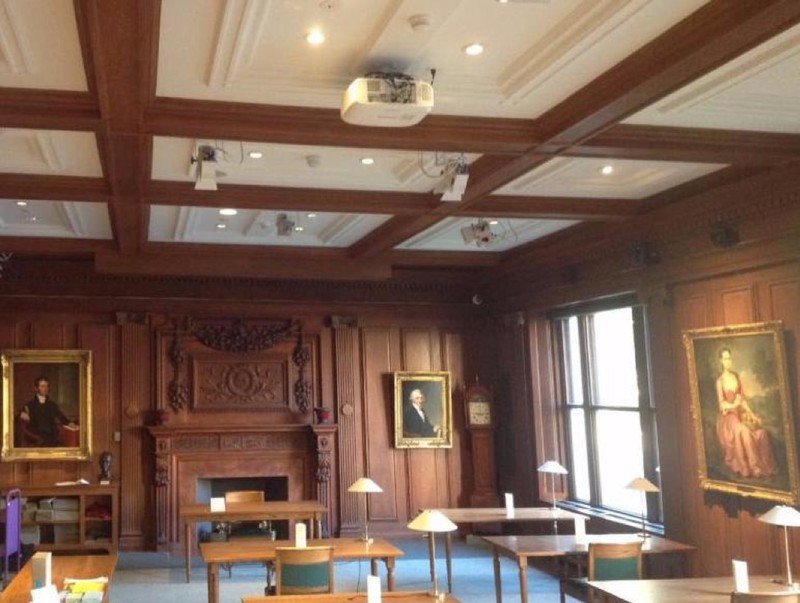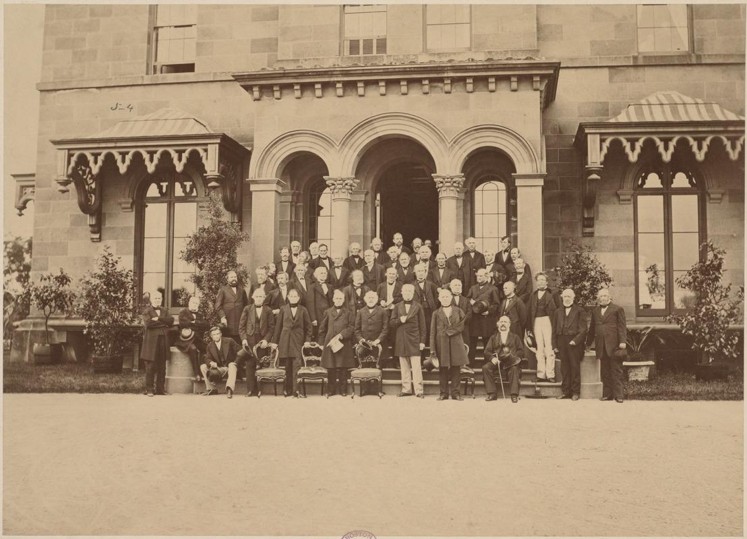Massachusetts Historical Society
Introduction
Text-to-speech Audio
Images
The Society also offers free tours of its building, which is a National Historic Landmark, as well as rotating exhibitions and public lectures. The building has been the location of the society since 1899. (Courtesy of Wikipedia, labelled for reuse)

Ellis Hall reading room, the Society's primary lecture space. This room was named after former Society president George E. Ellis. This is also the room in which documents can be brought out and examined. (Photo by Peter Vanderwarker, 2001)

Photograph taken June 10 1869 of Society members standing on the front steps of Society President R.C. Winthrop's house in Brookline (Courtesy Massachusetts Historical Society)

Backstory and Context
Text-to-speech Audio
The Historical Society was initially established in 1791 by the Reverend Jeremy Belknap. Belknap invited nine friends with similar interests to organize and form the first repository in the nation for the study of American history. Since it was the first of its kind, it originally collected items with national significance. Later, as other historical organizations with a national focus proliferated, the Historical Society narrowed its focus to the history of New England, and Massachusetts in particular.
The Society has held a number of historic homes, including the Massachusetts Bank, Faneuil Hall, the Tontine Crescent development, Tremont St., and its current location at 1154 Boylston St.
There are over twelve million documents and artifacts in the Massachusetts Historical Society’s vast collection. Today, they are available digitally on the Society's online catalog. In addition to digitization, the Society reaches public audiences with education initiatives including teacher workshops and Massachusetts History Day.
The Society’s most popular exhibits are the personal papers belonging to presidents John Adams, John Quincy, and Thomas Jefferson. Jefferson’s papers include an autographed copy of the Declaration of Independence and his architectural drawings. The Society also has volumes of John Winthrop’s journal, Washington’s Newburgh Address, the Linzee and Prescott swords, and Samuel Sewall’s antislavery pamphlet “The Selling of Joseph.” The society also boasts the “national treasures” of Paul Revere’s autobiographical account of his famous ride and Abigail Adams’ original “Remember the Ladies” letter. Uniquely, the Society has also published its own books since 1792, making it one of America's oldest publishers.
The Society elected its first female member, Frances Manwaring, in 1849, and today the Society has open membership. Scholarly and amateur research is welcomed, and complete information about hours and library access are available on the Society's website.
Sources
“Massachusetts Historical Society. Founded 1791.” Massachusetts Historical Society: 54th Regiment, www.masshist.org/.
“Center for the Teaching of History.” Massachusetts Historical Society: 54th Regiment, www.masshist.org/teaching-history/?goto=teaching-history.
“Massachusetts Historical Society.” Wikipedia, Wikimedia Foundation, 12 Aug. 2018, en.wikipedia.org/wiki/Massachusetts_Historical_Society.
Polly Rettig & S. Sydney Bradford. National Park Service - National Register of Historic Places Nomination Form. October 15, 1966. https://npgallery.nps.gov/GetAsset/899180ba-f682-41ed-8a46-d13f5ad07619.